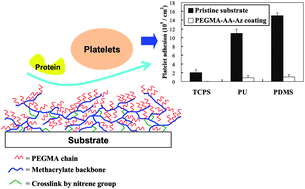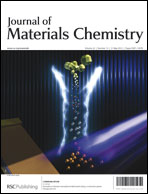PEGylation of biomaterials is a common way to effectively enhance hemocompatibility of a substrate. In this study, photoimmobilization of poly(PEGMA) was applied to prepare an anti-fouling substrate for improving biomaterials' hemocompatibility. Poly(ethylene glycol) methacrylate (PEGMA) was firstly copolymerized with acrylic acid (AA), which was then used for conjugation with photosensitive azidoaniline molecules. The synthesized copolymers were coated onto several substrates, such as tissue culture polystyrene, polyurethane, and polydimethylsiloxane, and then covalently immobilized on the substrates by exposure to UV radiation. The crosslinked poly(PEGMA-co-AA) coated surfaces revealed excellent blood compatibility. Platelet adhesion and fibrinogen adsorption to the PEGylated substrates were reduced significantly compared to the untreated substrate. The ability to inhibit platelet adhesion was increased with increasing PEG content in the copolymer. The UV-crosslinked PEG was very stable in both the acid and alkaline conditions and could be applied to various materials. Therefore, we demonstrate that this approach is considered an effective method for the preparation of bioinert surfaces to improve hemocompatibility of biomaterials.

You have access to this article
 Please wait while we load your content...
Something went wrong. Try again?
Please wait while we load your content...
Something went wrong. Try again?


 Please wait while we load your content...
Please wait while we load your content...